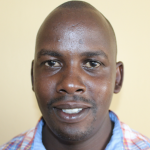In 2014, community members and the Salvation Army Church began Salvation Army Matioli Secondary School to bring education closer to home for the area's students. Beginning with just 108 students, today, the school serves 344 students and 29 teachers and staff. Something else has grown in step with the school's population: their severe shortage of clean and safe water.
There are two different water sources on school grounds, but there are challenges with each. The school relies on a shallow well without a hand-pump and a small plastic rain tank for water.
First, both the well and the rain tank are seasonal, meaning they dry up during part of the school year. The rain tank is seasonal due to its small size, whereby the students deplete the water very quickly. Students access the rain tank water through a standpipe from the grass a few meters away from the tank.
When it is not dry, it is more difficult to access water from the well. Without a hand-pump, students have to lower a 10-liter bucket attached to a rope down the 40-foot well, submerge it, then haul it back up to pour the fetched water into their containers to carry back to the school kitchen.
The process is time-consuming and tiring, and students often scramble for water as no one wants to be scolded for being late to class. Because it is shallow and not fully sealed off, the well water's safety is also questionable. The bucket and rope, handled by many different students on any given day, contaminate the well each time they are lowered into the water.
According to school principal Madam Ruth Mayavi, the school has recorded waterborne diseases among the students. These are expensive to treat and keep students out of class while they recover, affecting their academic performance.
The lengthy process of fetching water at the well delays students trying to get to their morning classes, along with any other time of day. They must fetch more water for all of the school's drinking, cooking, and cleaning needs. Still, many of these needs are going unmet.
"Cleaning of our classrooms and our sanitation facilities is not done daily because of inadequate water in the school. This makes our sanitation facilities full of a bad smell. Besides that, we waste a lot of time lining up for water in the school well when washing our utensils after lunch," explained student Carlos.
"Water challenges in the school cannot affect the learners alone; it also affects the teaching staff because if classes are dirty, it will not be conducive to teaching. Also, the challenges of long queues for water consume a bit of time scheduled for lessons, so one ends up teaching in less than the required time," said Principal Mayavi.
What We Can Do:
Rain Tank
A 75,000-liter rainwater catchment tank will help alleviate the water crisis at this school. The school will help collect the needed construction materials such as sand, bricks, rocks, and water for mixing cement. We will complement their materials by providing an expert team of artisans, tools, hardware, and the guttering system. Once finished, this tank will begin catching rainfall used by the school’s students and staff for drinking, handwashing, cooking, cleaning, and much more.
The school and we strongly believe that all of these components will work together to improve standards at this school, which will help lead to better student academic performance and unlock the potential for these students to live better, healthier lives.
Handwashing Stations
The student health club will oversee the two new handwashing stations we will provide and ensure they are kept clean and in working condition. The club leaders will fill the handwashing stations with water daily and make sure they are always supplied with a cleaning agent such as soap or ash.
VIP Latrines
Two triple-door latrine blocks will be constructed with local materials that the school will help gather. Three doors will serve the girls, and three doors will serve the boys. These new latrines will have cement floors designed to be easy to use and clean. And with a rain tank right on school property, there should be enough water to keep them clean.
Training on Health, Hygiene, COVID-19, and More
We will hold a one-day intensive training session with students, teachers, and parents. This training will cover a wide range of topics, including COVID-19 symptoms, transmission routes, prevention; personal and environmental hygiene; and the operation and maintenance of the rain tank, latrines, and handwashing stations. There will be a special emphasis on handwashing.
Our team of facilitators will use various methods to train, including participatory hygiene and sanitation transformation and asset-based community development. We will initiate a student health club, which will prepare students to lead other pupils into healthy habits at school and home. We will also lead lectures, group discussions and provide illustrative handouts to teach health topics and promote good hygiene practices within the school, including handwashing and water treatment. We will then conduct a series of follow-up training before transitioning to our regularly scheduled support visits throughout the year.

 Rainwater Catchment
Rainwater Catchment
 Rehabilitation Project
Rehabilitation Project












































